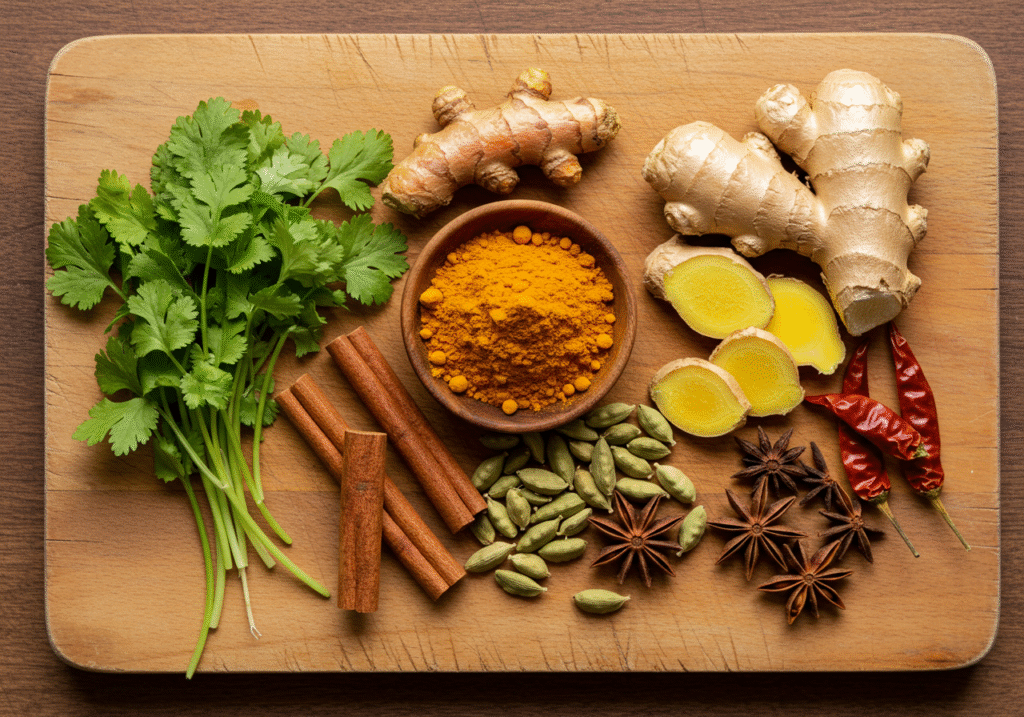Meta Description: Discover how ancient Ayurveda practices blend with modern wellness trends in 2025. Learn dosha balancing, herbal remedies, and mindful living for optimal health.
Introduction
Remember that feeling when you wake up naturally, completely refreshed, without an alarm clock? That’s what happened to me after just three weeks of following Ayurvedic principles. I’ll be honest – I was skeptical at first. How could a 5,000-year-old system possibly address my modern stress, irregular sleep, and constant digestive issues?
But here’s the thing: Ayurveda isn’t just about ancient wisdom anymore. In 2025, this holistic healing system has seamlessly woven itself into contemporary wellness culture, and for good reason. With the global Ayurveda market projected to reach nearly $77 billion by 2030, it’s clear that more people are discovering what I learned – that these time-tested practices offer exactly what our overstimulated lives need.
Whether you’re completely new to Ayurveda or looking to deepen your practice, this guide will show you how to integrate these powerful principles into your modern lifestyle for genuine, lasting wellness.
Understanding Your Unique Constitution: The Foundation of Ayurvedic Wellness
The beauty of Ayurveda lies in its personalized approach. Unlike one-size-fits-all wellness trends, Ayurveda recognizes that each person has a unique constitutional type, or “prakruti,” determined by three doshas: Vata (air and space), Pitta (fire and water), and Kapha (earth and water).
Think of your dosha as your body’s operating system. When it’s running smoothly, you feel energized, focused, and healthy. When it’s out of balance, you experience everything from digestive issues to sleep problems to mood swings.
Vata types tend to be creative, energetic, and quick-thinking, but they’re prone to anxiety, irregular digestion, and scattered energy. Pitta individuals are natural leaders with strong digestion and sharp intellects, though they can struggle with irritability and inflammation. Kapha people are grounded, loyal, and naturally strong, but may experience sluggishness and weight gain when imbalanced.
Most of us are actually a combination of two doshas, which is why understanding your unique constitution is so powerful. Once you know your primary dosha, you can tailor everything from your diet to your exercise routine to support your natural tendencies rather than fighting against them.
Simple Dosha Assessment
Pay attention to your natural preferences and tendencies:
- Do you get cold easily and prefer warm foods? (Vata)
- Do you have a strong appetite and prefer cooler environments? (Pitta)
- Do you have steady energy but sometimes feel sluggish? (Kapha)
Ayurvedic Nutrition: Eating for Your Dosha in 2025
Here’s where Ayurveda gets really practical. Instead of following the latest diet trend, you’re eating based on what your unique constitution actually needs. This approach has gained significant traction in 2025, as people move away from restrictive dieting toward intuitive, personalized nutrition.
For Vata types: Warm, cooked foods are your best friend. Think hearty stews, roasted vegetables, and warming spices like ginger and cinnamon. I’ve been loving this Hamilton Beach Slow Cooker from Amazon for preparing nourishing, dosha-balancing meals that cook while I work. Raw salads and cold foods can actually aggravate Vata, leaving you feeling more scattered and anxious.
For Pitta individuals: Cool, refreshing foods help balance your natural fire. Fresh fruits, leafy greens, and cooling herbs like mint and cilantro are ideal. Avoid spicy, oily, or fried foods that can increase heat and irritability in your system.
For Kapha constitution: Light, warm, and spicy foods help stimulate your naturally slower metabolism. Think steamed vegetables, lean proteins, and warming spices like turmeric and black pepper. Heavy, oily, or sweet foods tend to increase sluggishness.
The key is eating mindfully and seasonally. In winter, everyone benefits from warmer, more grounding foods, while summer calls for lighter, cooling meals regardless of your dosha.

Daily Rhythms: Aligning with Natural Cycles
One of the most transformative aspects of Ayurveda is its emphasis on daily rhythms, or “dinacharya.” Our bodies naturally follow circadian rhythms, and Ayurveda has always recognized this connection between our internal clocks and optimal health.
Morning Rituals (6-10 AM – Kapha Time): Wake up before sunrise when possible, and start with gentle practices that stimulate circulation. This includes tongue scraping, oil pulling, and gentle movement. The natural heaviness of Kapha time makes this ideal for establishing grounding routines.
I’ve found that using a Copper Tongue Scraper from Amazon first thing in the morning makes a huge difference in how I feel throughout the day. It sounds simple, but this ancient practice removes toxins that accumulate overnight and improves both taste and digestion.
Midday Focus (10 AM-2 PM – Pitta Time): This is when your digestive fire is strongest, making it the ideal time for your largest meal. It’s also prime time for focused work and important decisions, as Pitta energy supports clarity and determination.
Evening Wind-Down (6-10 PM – Kapha Time): As Kapha energy returns, your body naturally prepares for rest. This is the perfect time for gentle yoga, meditation, or relaxing activities that don’t overstimulate the nervous system.

Modern Stress Management Through Ancient Wisdom
Here’s where Ayurveda really shines in our modern world. While we’re dealing with entirely new stressors – constant notifications, information overload, social media pressure – the fundamental solutions remain surprisingly timeless.
Pranayama (Breathing Practices): Different breathing techniques balance different doshas. For Vata types prone to anxiety, slow, deep breathing helps ground scattered energy. Pitta individuals benefit from cooling breaths that release heat and tension. Kapha types need energizing breaths that stimulate circulation and motivation.
Meditation and Mindfulness: Ayurveda has always emphasized the connection between mind and body. Regular meditation doesn’t just reduce stress – it actually helps rebalance your doshas by calming the nervous system and improving cellular communication.
Abhyanga (Self-Massage): This daily oil massage practice might seem indulgent, but it’s actually a powerful tool for nervous system regulation. Using warm sesame oil for Vata types, coconut oil for Pitta, or sunflower oil for Kapha creates a protective barrier that helps your body handle daily stressors more effectively.
A quality Organic Sesame Oil from Amazon makes this practice accessible and affordable. The ritual of self-massage before showering becomes a daily act of self-care that accumulates profound benefits over time.

Seasonal Living: Adapting Your Practice Throughout the Year
Ayurveda recognizes that optimal health requires adapting to natural seasonal changes. In 2025, as climate change makes weather patterns more unpredictable, these principles become even more relevant for maintaining balance.
Spring (Kapha Season): As nature awakens, focus on lighter foods, increased movement, and detoxifying practices. This is the ideal time for gentle cleanses and more vigorous exercise routines.
Summer (Pitta Season): Cool, calming practices become essential. Favor swimming over intense cardio, choose cooling foods, and practice moderation in all activities to prevent overheating.
Fall/Winter (Vata Season): Emphasize grounding, warming practices. Increase healthy fats, maintain regular routines, and focus on practices that calm the nervous system rather than stimulate it.
The key is paying attention to what your body needs as seasons change, rather than maintaining the same routine year-round.
Integrating Ayurveda with Modern Healthcare
One of the most exciting developments in 2025 is how Ayurveda complements rather than competes with conventional healthcare. Many integrative medicine practitioners now incorporate Ayurvedic principles into treatment plans, recognizing that personalized, holistic approaches often produce better outcomes than standardized protocols.
This doesn’t mean abandoning modern medicine – it means using Ayurvedic practices to support your overall health foundation. Regular exercise, stress management, proper nutrition, and adequate sleep form the cornerstone of any wellness approach, whether ancient or modern.

Building Your Personal Ayurvedic Practice
Starting an Ayurvedic practice doesn’t require dramatic lifestyle changes overnight. Begin with one or two practices that resonate with your constitution and current needs:
Week 1-2: Focus on eating your largest meal at midday and establishing regular sleep times.
Week 3-4: Add morning tongue scraping and a simple breathing practice.
Month 2: Incorporate appropriate seasonal foods and a weekly self-massage routine.
Month 3 and beyond: Gradually add more practices based on what feels supportive and sustainable.
Remember, Ayurveda is about creating harmony, not perfection. Some days you’ll skip your morning routine or eat foods that don’t perfectly match your dosha – and that’s completely normal. The goal is developing a deeper awareness of what truly supports your wellbeing.

Conclusion
After months of integrating these practices into my daily life, I can honestly say that Ayurveda has given me something I didn’t even realize I was missing – a sense of being truly at home in my own body. The constant low-level anxiety I carried for years has largely disappeared, my digestion is better than it’s been in decades, and I sleep like the proverbial baby.
The beautiful thing about Ayurveda is that it meets you wherever you are. Whether you’re dealing with chronic stress, digestive issues, or simply want to feel more energized and balanced, these ancient practices offer practical, personalized solutions that actually work in our modern world.
Start small, be consistent, and pay attention to how your body responds. Consider trying that morning tongue scraping routine with a quality copper scraper, or begin your day with five minutes of dosha-appropriate breathing. Your future self will thank you for taking this step toward deeper, more authentic wellness.
What aspect of Ayurveda are you most excited to try? Share your thoughts in the comments below – I’d love to hear about your journey toward balanced living!









